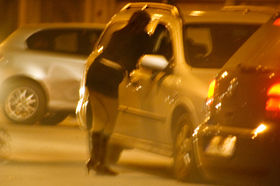Street prostitution

Street prostitution is a form of prostitution in which a prostitute solicits customers from a public place, most commonly a street, while waiting at street corners or walking alongside a street, but also other public places such as parks, benches, etc. The street prostitute is often dressed in a provocative manner. The sex act may be performed in the customer's car, in a nearby secluded street location, or at the prostitute's residence or in a rented motel room.[1]
Legality
[edit]Street prostitution is often illegal, even in jurisdictions that allow other forms of prostitution.[2]
It is estimated that only 10-20 percent of sex workers are working on the streets; however, it is also estimated that 90 percent of the arrests of prostitutes are of street workers.[3]
In some jurisdictions where prostitution itself is legal, such as in the United Kingdom, street prostitution has been made illegal.[4]
Some jurisdictions also outlaw kerb crawling, slowly driving around with the intent to procure the services of a prostitute.
In Australia, in New South Wales it is legal to solicit on the streets, except in some areas (such as near schools).[5] The other Australian states and territories prohibit street solicitation,[6] although some of these jurisdictions allow licensed brothels.[7]
Street prostitution is legal in New Zealand.[8] In Germany it is allowed too, but cities can restrict it to certain areas or hours (regulations vary widely from place to place).[9]
In the United States, street prostitution is illegal in all 50 states; 49 of the states outlaw all forms of prostitution. Nevada allows licensed brothels, but only in some rural areas, not in the major metropolitan areas (only eight counties have active brothels and prostitution outside these brothels is illegal throughout the state).
In four towns in the Netherlands, a special zone (tippelzone) is designated for legal street prostitution.[10] The zone is often in a business park to avoid inconvenience for residents and can include a sex drive-in (afwerkplek).[11] In most of the zones, the prostitutes need a licence.[10]
Risks and research
[edit]Street prostitutes are extremely vulnerable to physical and sexual assaults, as well as to muggings by clients and pimps.[12]
The World Health Organization reported that a study in Bangladesh found that between 50% and 60% of street-based prostitutes had been raped by men in uniform, and between 40% and 50% had been raped by local clients.[12]
Melissa Farley's study of 854 prostitutes in nine countries—Canada, Colombia, Germany, Mexico, South Africa, Thailand, Turkey, the United States, and Zambia—found that 95% of prostitutes had been physically assaulted, and 75% had been raped. 89% of the women interviewed stated that they wanted to leave prostitution.[13]
In a 2008 study of Chicago, USA street prostitutes, economists Steven D. Levitt and Sudhir Alladi Venkatesh found that women working without pimps work for an average hourly rate of about $25, and those working with pimps make 50% more. This is roughly four times the wage of other jobs available to them. Prostitutes are arrested once for every 450 encounters and every 10th arrest results in jail time.[14]
In 2004, a study in the UK showed that up to 95% of women in street prostitution were problematic drug users, including around 78% heroin users and rising numbers of crack cocaine addicts.[2]
Impact of COVID-19
[edit]During the COVID-19 pandemic, contact professions (which includes prostitution, amongst others) had been banned (temporarily) in some countries. This has resulted in a local reduction of prostitution.[15]
See also
[edit]References
[edit]- ^ Harcourt, Christine; Donovan, Basil (June 2005). "The Many Faces of Sex Work". Sexually Transmitted Infections. 81 (3): 201–206. doi:10.1136/sti.2004.012468. PMC 1744977. PMID 15923285. Retrieved 24 February 2018.
- ^ a b "Paying the Price: a consultation paper on prostitution" (PDF). UK Home Office. 2004. Retrieved 24 February 2018.
- ^ Lucas, Ann (September 2013). "Race, Class, Gender, and Deviancy: The Criminalization of Prostitution". Berkeley Journal of Gender, Law & Justice. 10 (1): 48–49. doi:10.15779/Z38758N.
- ^ S. 1(1) of the Street Offences Act 1959 as amended by section 16 of the Policing and Crime Act 2009
- ^ Summary Offences Act 1988 (NSW).
- ^ Summary Offences Act 1953 (SA).
- ^ Sex Work Act 1994 (Vic).
- ^ "Prostitution Reform Act 2003". legislation.govt.nz. Retrieved 12 March 2016.
- ^ Gunter, Joel; Ben, Clissitt. "Welcome to Paradise". Telegraph. Retrieved 24 February 2018.
- ^ a b "Street prostitution". Soa Aids Nederland. Retrieved 24 February 2018.
- ^ (18 August 2008). Onderzoek naar ruimere afwerkplek, Algemeen Dagblad (in Dutch) (article states prostitutes are reporting that the stalls in the Utrecht facility are too small for some luxury cars and SUVs, as the facility has remained mostly unchanged since its construction in 1986)
- ^ a b "World Health Organization" (PDF). World Health Organization. Retrieved 24 February 2018.
- ^ Farley, Melissa; Cotton, Ann; Lynne, Jacqueline; Zumbeck, Sybille; Spiwak, Frida; Reyes, Maria E.; Alvarez, Dinorah; Sezgin, Ufuk (2004). "Prostitution and Trafficking in Nine Countries". Journal of Trauma Practice. 2 (3–4): 33–74. doi:10.1300/j189v02n03_03. S2CID 153827303.
- ^ Steven D. Levitt (April 2009). "Trading Tricks: The Economics of Prostitution". The University of Chicago Booth School of Business. Archived from the original on 22 March 2016. Retrieved 14 April 2016.
- ^ "Impact of COVID-19 on Sex Workers in Europe". Global Network of Sex Work Projects. 6 July 2020.
External links
[edit]- Street prostitution Archived 2003-11-29 at the Wayback Machine by Michael S. Scott, US DOJ Problem-Oriented Guides for Police Series, No. 2 (PDF file)
